Non-native insects have been attacking many native plants in our region (and in many other areas).
Currently, the emerald ash borer is a huge problem, but it’s only one of many that will be disastrous for our whole region. (I’m saying “will” — not “could” — since it appears that some problems are inevitable at this point.) Fortunately, we don’t have an ash tree.
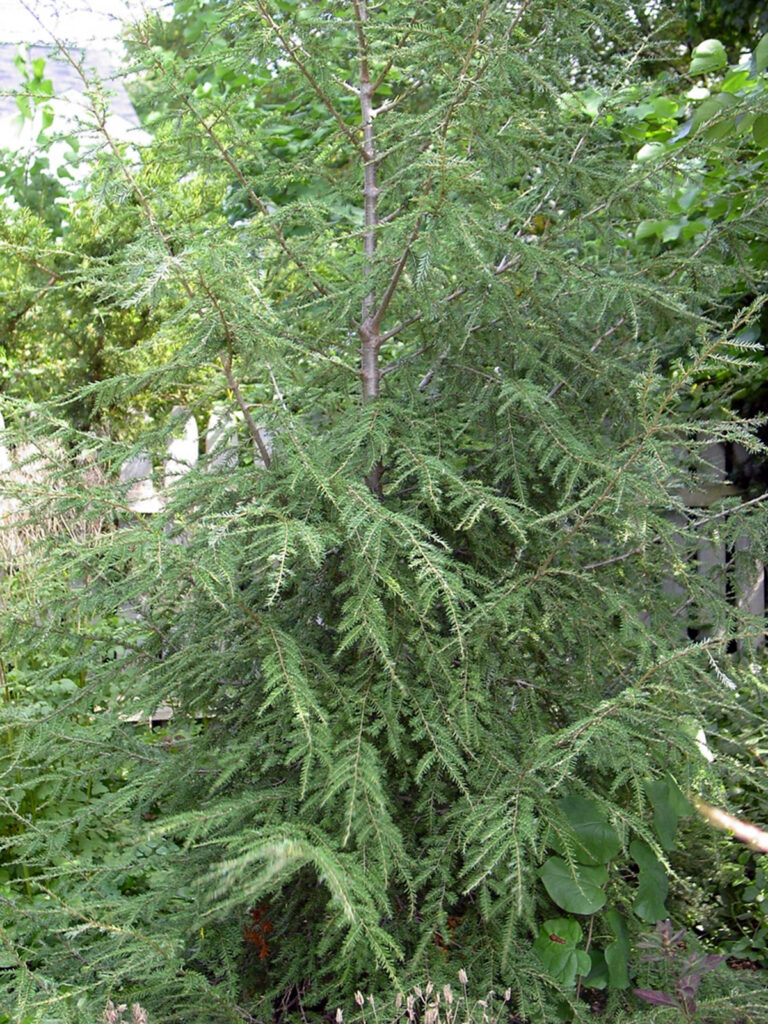
We do, however, have a few hemlocks. So far we’ve been lucky and haven’t seen the hemlock wooly adelgid.
There appears to be a cure for that problem, but only on the scale of the home landscape, not in forests, since it involves treating individual trees.
Below are some of the non-native invasive insects we have found in our yard.
Japanese beetles
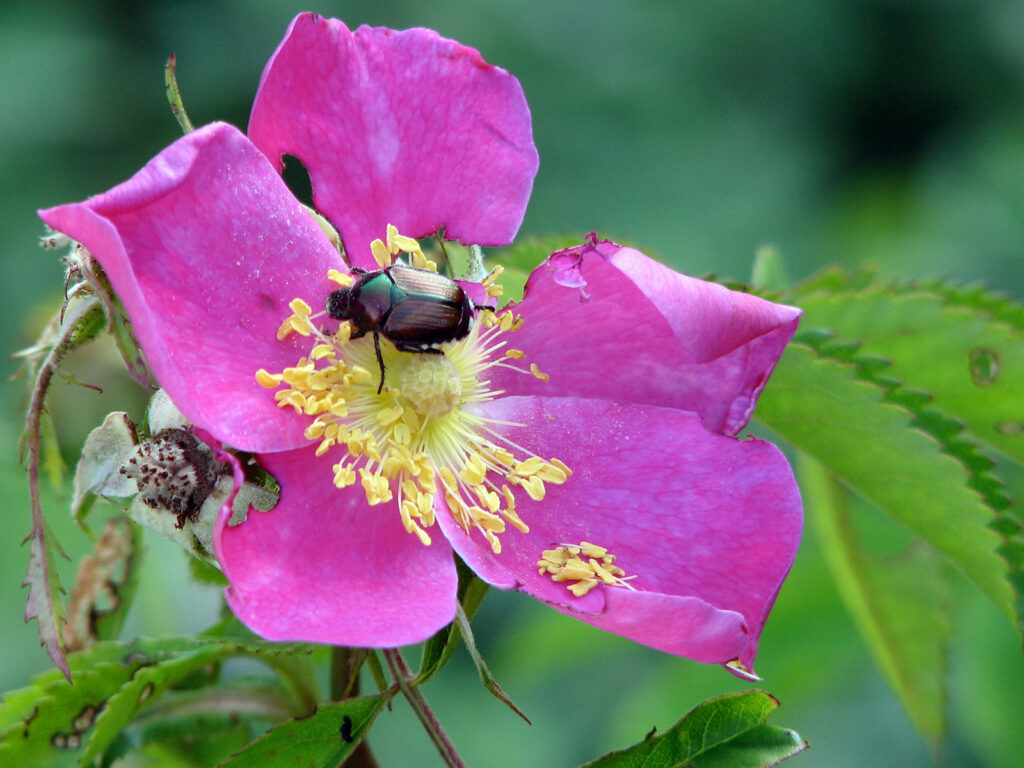
Our population of Japanese beetles varies from year to year. I think if people had less lawn area, we might see a big decrease in the population, though, since their grubs live in the soil under turf grass.
Regardless of the size of the population, they usually arrive in our yard right around the Fourth of July.
Beetle traps?
Summer 2010 was an especially bad year for Japanese beetles (or, rather, a good year for the beetles, bad year for our plants …), so we decided to again try the Japanese beetle traps for the first time in many years.
Even though people say that they just attract beetles that wouldn’t otherwise be in your yard, we figured we had so many that summer we couldn’t be in any worse shape. We concluded that the traps seemed to be worth having when there’s an especially severe infestation. We haven’t used these traps since, though, and haven’t had a need to.
Trap plants

Instead, we just go around with a jar of soapy water and knock them off into the jar. (And as you can see from this vintage photo, we’ve been doing this a long time!) They’re lethargic in the early morning, so that’s the best time to get them.
It’s most efficient to look for them on their favorite plants — in other words, trap plants.
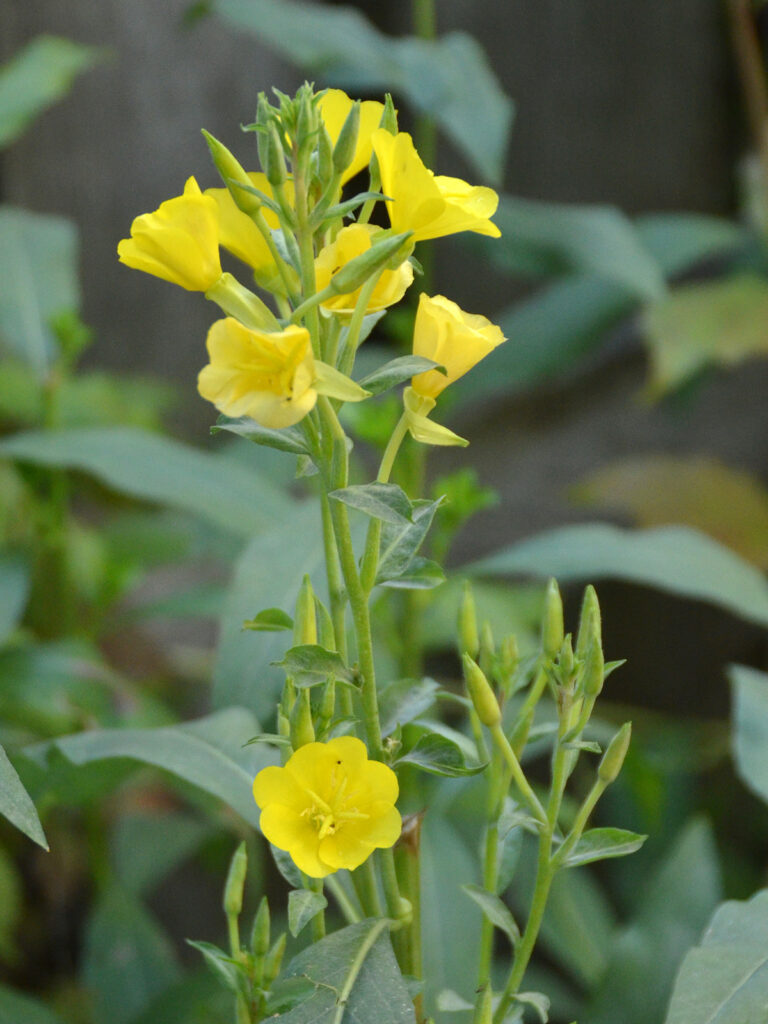
In our yard, they like biennial primrose and Canada burnet and the flowering raspberries.
At least in our yard, their favorite seems to be biennial primrose (Oenothera biennis), so much so that I’ve decided to grow a few more of these “trap plants” so I can “harvest” the beetles efficiently by just going to these plants.
Since I’m collecting them frequently, they don’t seem to harm the plants unduly.
Asian ladybug (Harmonia axyridis)
There are many types of Asian ladybugs, which have multiplied to the detriment of our native ladybugs. Why? Probably because they were sold as a biocontrol for aphids.
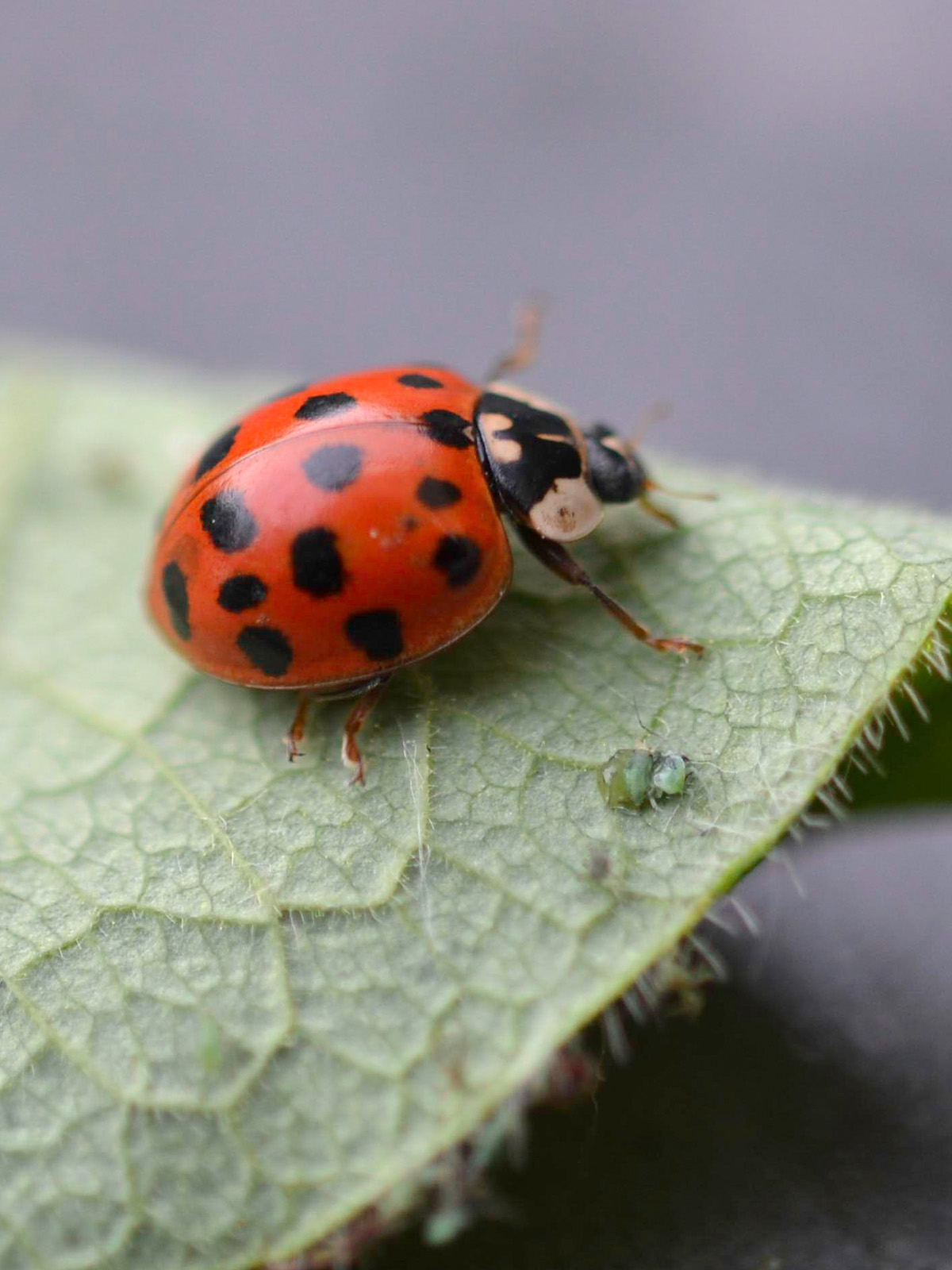
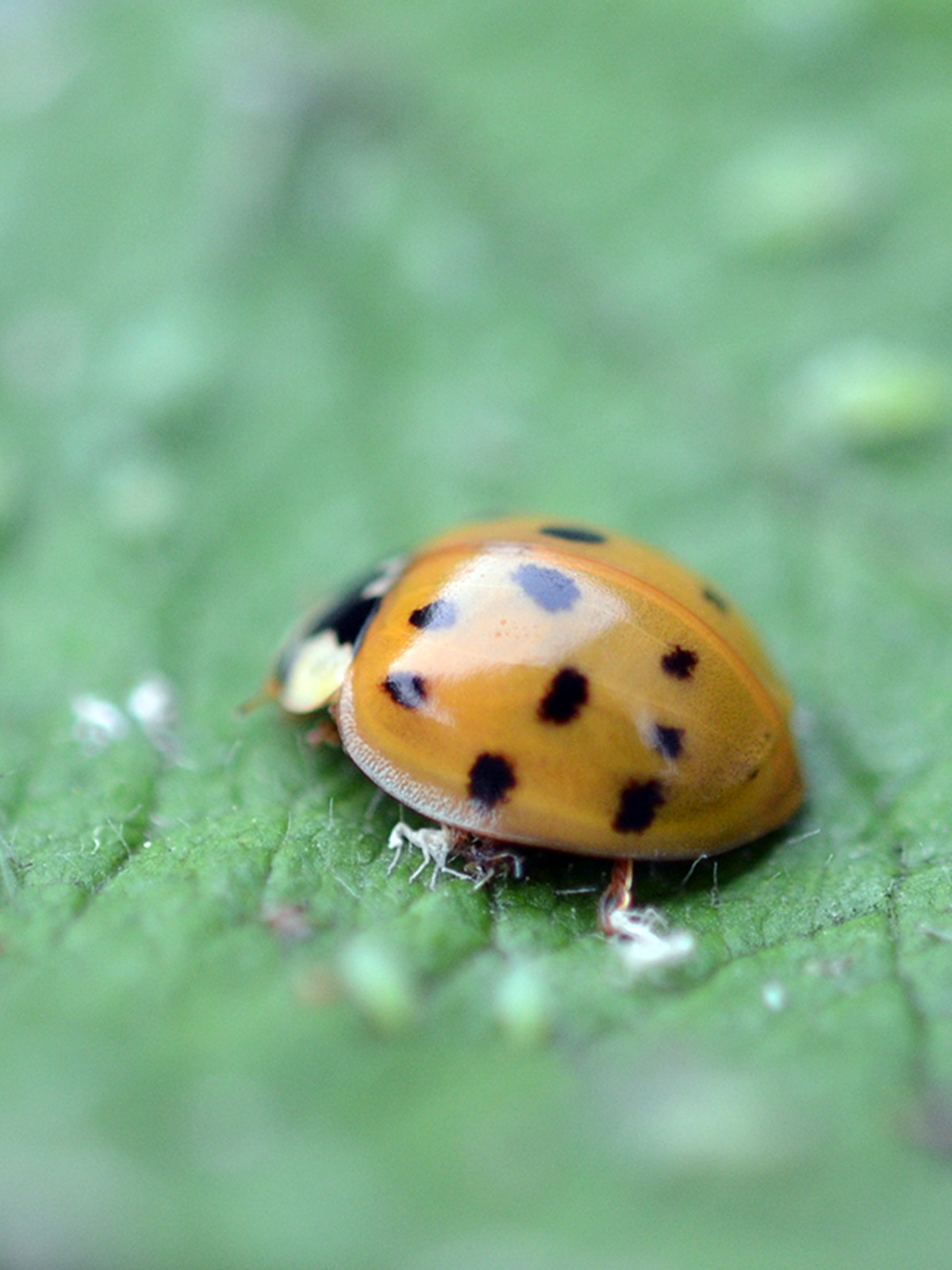
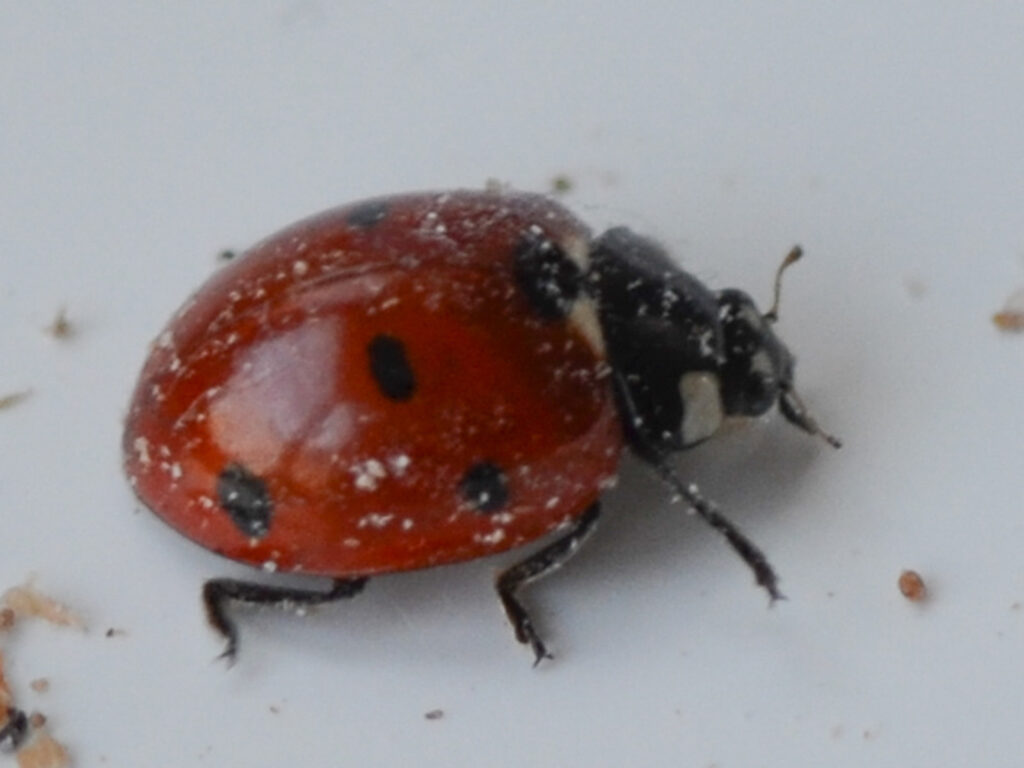
This is a seven-spotted Eurasian ladybug.
- Learn more:
- Lost Ladybug Project – about the decline of native ladybugs
Cabbage white (Pieris rapae)
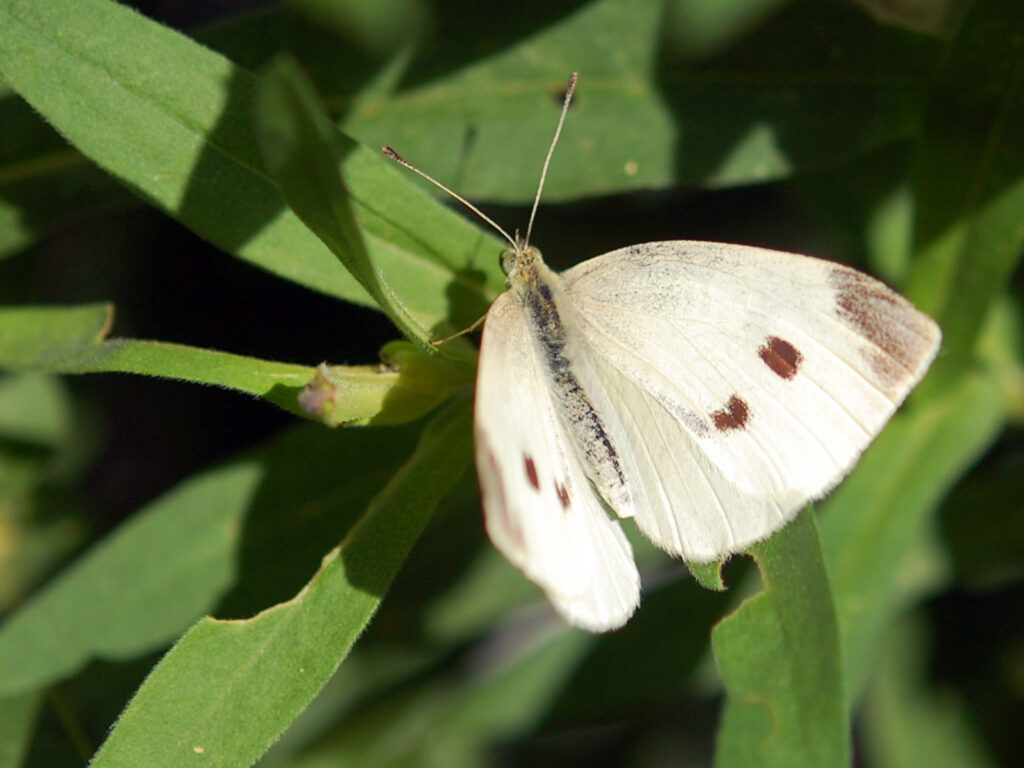
A widespread, abundant non-native import from Europe and was brought to this country in the 1860s. They’re all over our yard, creating a problem not just for our edible garden, but also competing with our own native white butterflies.
HOST PLANTS: members of the mustard family such as cabbage, broccoli, brussel sprouts
More info at Butterflies and Moths of North America
Hibiscus sawfly
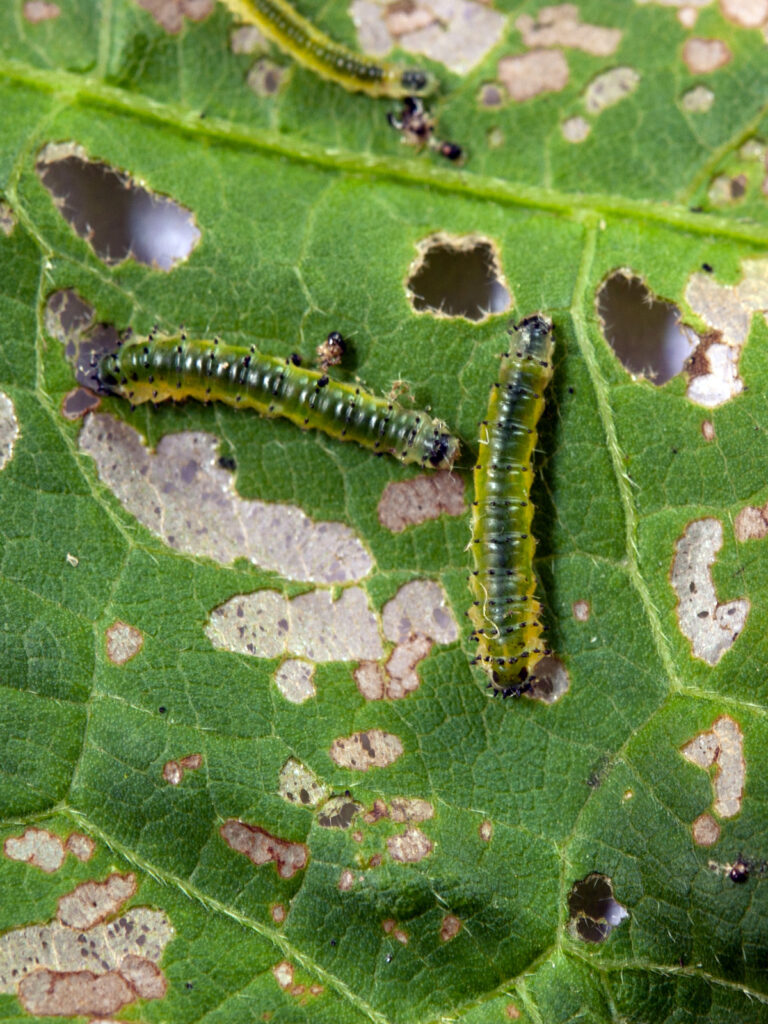
A new invader, the hibiscus/mallow sawfly (Atomacera decepta) appeared in our yard for the first time in 2011.
It’s actually native to the mid-Atlantic and Midwest states, so it’s not the typical Eurasian invading insect.
I have read that it’s expanding its range (perhaps due to climate change?) to other parts of the US.
These sawfly larvae are capable of completely defoliating the plant in a very short time. Usually we let things be and let an insect’s predator find this new source of food, but this didn’t seem like it would happen soon enough to save the plant.
- Learn more:
- Univ. of Maryland Extension: Bug of the Week: Mallow munchers
Brown marmorated stink bug
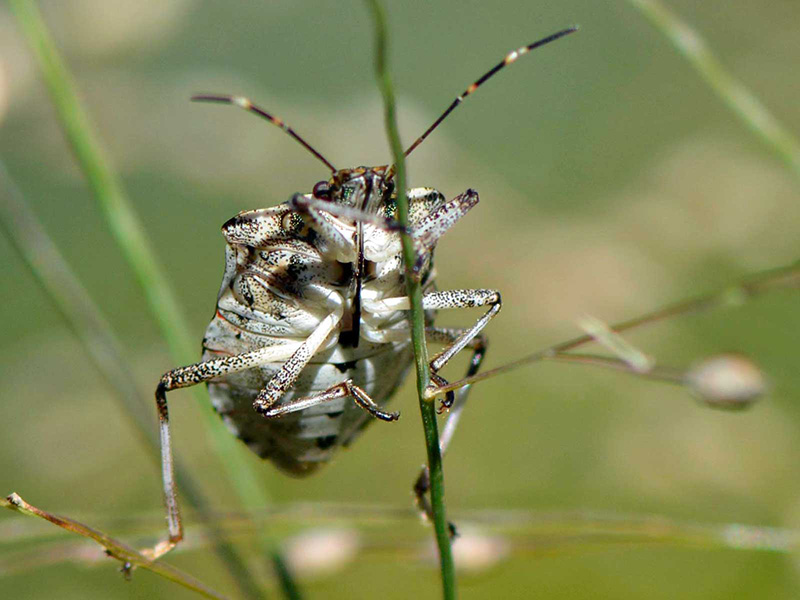
The BMSB, as it’s “affectionately” called, is another new-ish pest (shown in the introductory photo). In 2014 or so, we sent samples of one we found in our yard to a university that was studying it. Now we (and I suspect everyone else) see them so frequently that I don’t think they’re still asking for samples.
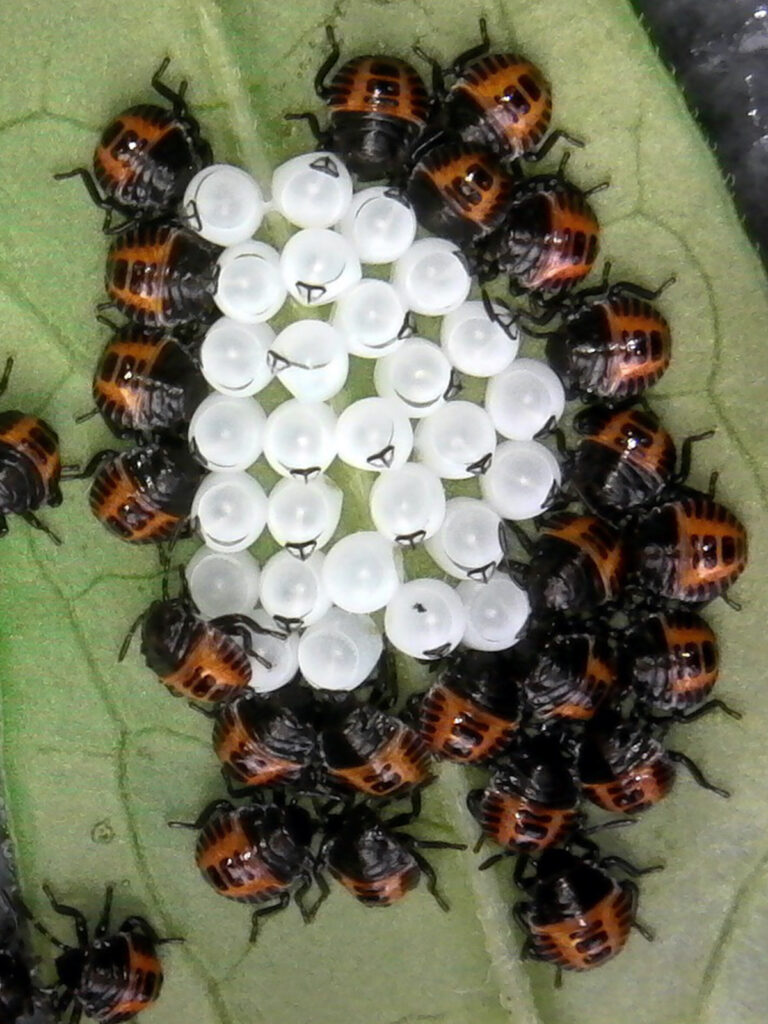
These may look like ladybugs, but they aren’t. They’re the BMSB larvae, having just hatched out of their eggs.
As an insect that isn’t native to our area, it’s not adapted to overwintering in our cold, snowy climate. So where does it go? Into our houses, of course! We don’t seem to have as large an infestation as other people, but they’re not appealing to find. We certainly don’t want to squash them, releasing their truly stinky odor, so we stick them in old glass spice bottles and put them in the freezer.
I haven’t noticed damage on our habitat plants, but we have found them in our edible garden. They have the potential to be a huge pest in agricultural areas, though, which is why scientists are studying them.
IMPORTANT NOTE: There are also NATIVE stink bugs, which we do NOT kill. The BMSB has stripes on its antennae.
Lily leaf beetle
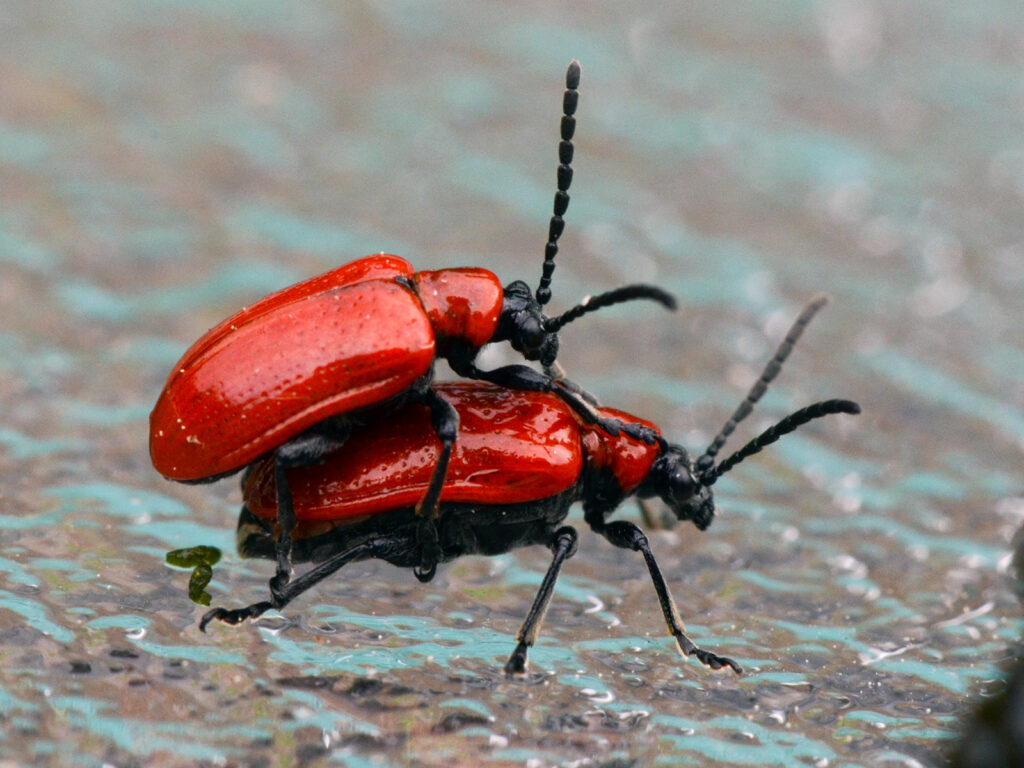
This is an Eurasian non-native beetle. We saw this first in 2015, covering what we had previously thought of as our native Turk’s cap lily. (We later realized that this plant is a non-native look-alike, which we have since removed.)
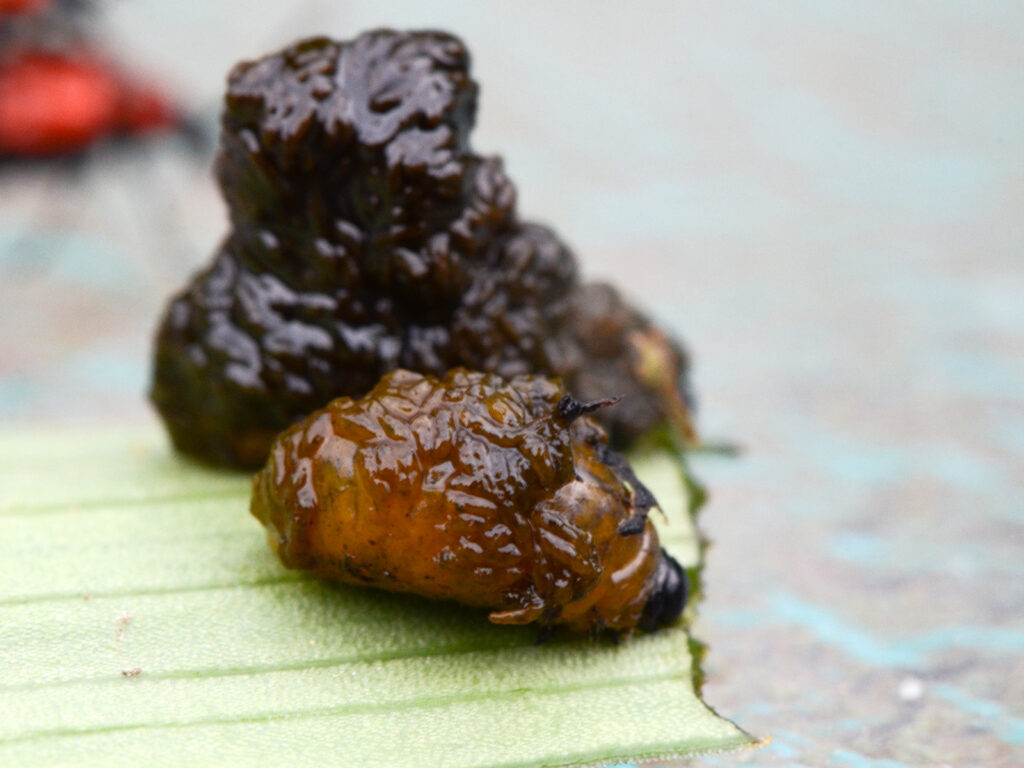
Besides damaging the plants, this beetle has a particularly gross larval stage, covering itself with its “fecal shield.”
Yes, it coats itself with its own poop — admittedly effective and disgusting to deal with.
Viburnum leaf beetle
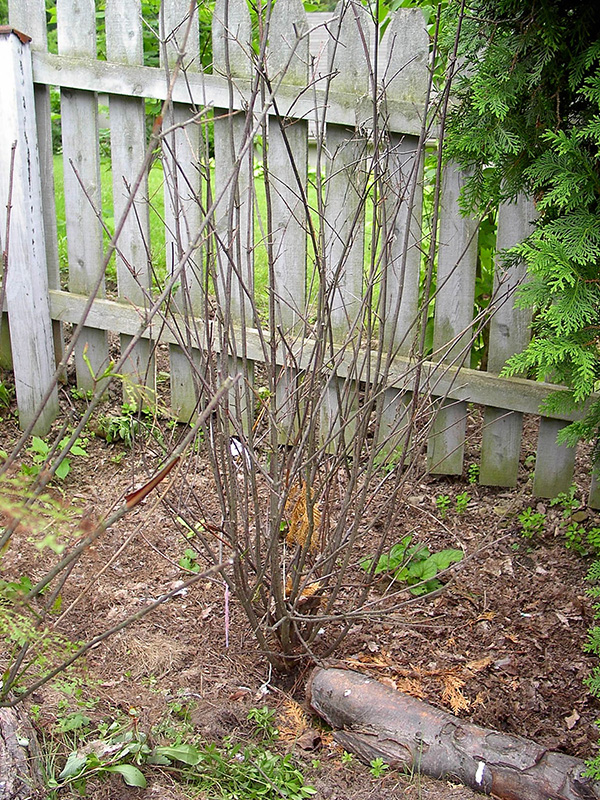
Our viburnums — especially our arrowwood viburnums — were hard-hit by the invasive viburnum leaf beetle that arrived in the early 2000s.
Unfortunately, we had just planted $100 worth of these plants the year before the beetle arrived in our area.
And just as unfortunately, this native shrub turned out to be one of their favorites. Our arrowwoods were totally dead after two or three years.
Wouldn’t you know that the non-native viburnums were less affected. It makes sense, though, because the non-native shrubs probably have defenses against this non-native beetle whereas our native shrubs don’t.
Unfortunately, many “experts” recommend that people plant those non-native viburnums. What would be the point? For a while we had a blackhaw viburnum, ragged though it might have been. At least it supported life! It eventually outgrew its space, though, so we had to remove it. (Another victim of my tendency to plant what would become a large shrub too near the path …)
I suspect we’ll never be rid of this beetle, but perhaps its population has stabilized somewhat, especially as it has killed off so many of its host plants.
The honey bee
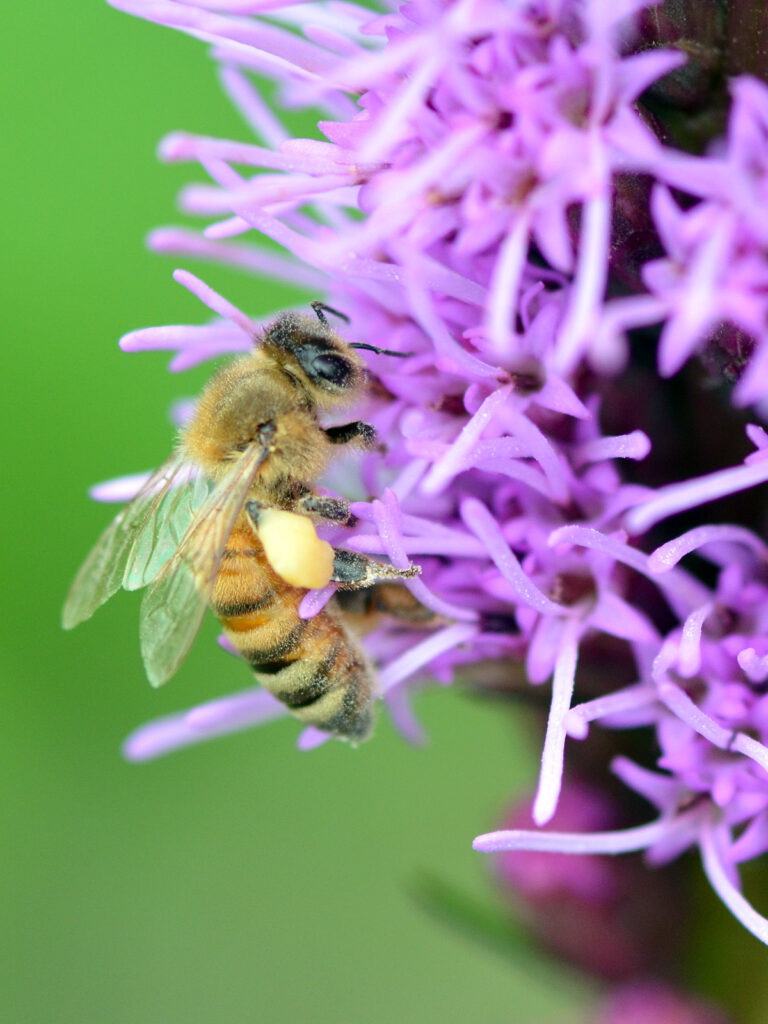
Commercial agriculture relies on honey bees to pollinate their acres of monocultures. But honey bees aren’t native to North America, and they may actually be harming our native bee populations by competing for ever-decreasing habitat resources.
They haven’t caused any problem that I’m aware of in my yard. I have many more native bees than honey bees and I have ample floral resources so I haven’t attempted to control them (as if I could), but I prefer to provide for native bees.
Resources
- NYS DEC:
- National Science Foundation / Cornell:
- Syracuse Post-Standard:
- Homegrown National Park:
- VIDEO: Emerald ash borers and Asian ash trees – short video by Doug Tallamy
- EPA:
- A Source Book on Natural Landscaping for Public Officials: A complete toolkit from the Great Lakes EPA, complete with case studies of communities, public institutions, and corporate campuses—includes economic benefits!
- EPA and Chicago Academy of Sciences video: Landscaping Naturally – describes benefits of natural landscaping in the community
- Xerces Society: an invertebrate conservation organization, has a wealth of resources on pollinator conservation for communities:
- A book: Attracting Native Pollinators: Protecting North America’s Bees and Butterflies. It has separate chapters on Land Management practices, Community Gardens, Urban Greenspaces and Parks, as well as a wealth of general information.
- Making Room for Native Pollinators – How to Create Habitat for Pollinator Insects on Golf Courses: Download this free 30-page full color book from this page
- Pollinator Conservation Resources: Great Lakes Region – Includes regional plant lists and more. New York State is in this Region, but Xerces has materials for all regions.
- Cool Green Science from The Nature Conservancy:
- Ecological Landscape Alliance:
- Cornell University Horticulture:
- Viburnum leaf beetle – a community science program about this beetle
- USDA:
- Stop the Brown Marmorated Stinkbug (BMSB)
- Native lookalikes of the BMSB and more lookalikes – leave the natives!
- Audubon:
Reflections
The effects [of the emerald ash borer and the hemlock wooly adelgid] will go far beyond what you see on a hike or how you feel about the loss of a tree on your property. They will ripple through forest ecosystems, affecting other plants, animals and water supplies.
~ Maggie Koerth-Baker, After the Trees Disappear, New York Times 6/30/14 – an excellent (though depressing) article (If you aren’t a NYT subscriber you may have to google the article title)
